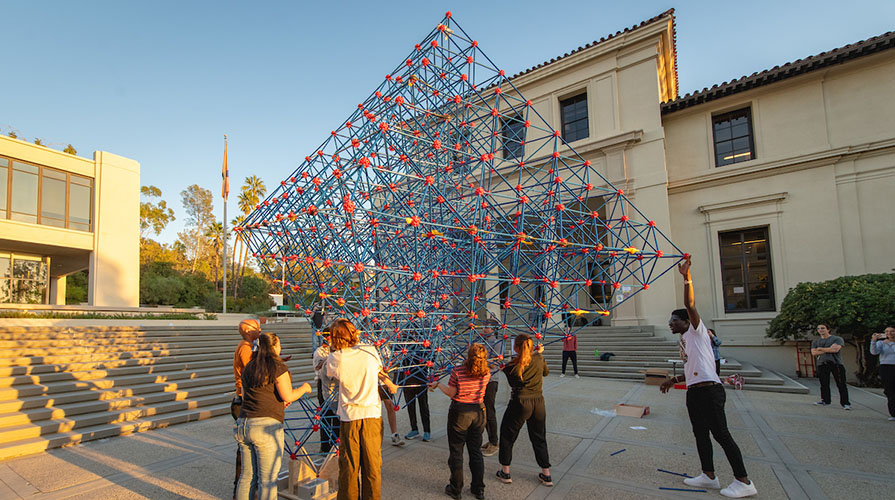
On Friday, November 10, students, professors, and mathematicians came together to construct the Oxyhedron.
It’s approximately 4:30 PM. I’m watching as a bunch of people hold up a massive, ill-fated structure in between Johnson and Fowler Hall. Glen Whitney, the founder of the National Museum of Mathematics, tells them, “On three, release your grip and run like hell.”
There aren’t many 17-foot-tall student constructions at Oxy, especially ones at the center of campus. Some of my friends (outside of the math department) who’d seen flyers of the upcoming event asked me about what was happening. I honestly wasn’t sure, but I had signed up to volunteer. Many of my friends had signed up as well and I was looking forward to spending time with them and the conversations that the Oxyhedron would spark. The general atmosphere around the construction was one of confidence; my friend and I planned on taking a picture in front of the completed structure and there were volunteers ready to take it down the following Monday.

Construction required a great deal of collaboration. A lot of the building depended on students and professors who had already worked on a blueprint, passing along their wisdom to any new faces that showed up. Sometimes there were connectors missing that others would catch. When I arrived, a couple of students had already begun construction on the “modules” that were printed on small sheets of paper. Each module depicted what was roughly an octahedron fractal, with some connectors or hubs missing for integration into the larger structure. The diagrams were tricky to interpret; it was hard to tell which connectors were meant to be sticking out, which connectors were attached to which hub, and whatever was going on in the back. I had no idea where to begin. Luckily, I got some advice from Peter, a math professor from Harvey Mudd College, who had dropped by after hearing that Glen was constructing something at Oxy. He gave me good starting points, suggesting that I first construct a square, as well as important pointers (apparently the arrows on the hubs had to be aligned with the connectors).
As I chatted with Peter, I was surprised to learn that he and I had something in common. He had obtained his bachelor’s degree from OSU, where I had done research over the summer. I made other friends as well, bonding over classes we were taking next semester, and what brought us to the event. There were many builders from outside the department as well - it was really funny hearing people say, “I don’t know why I’m here–I’m not even a math major.” But the most popular talking point by far was whether or not the structure we had worked so hard to build would collapse. (It was a certain and unanimous ‘yes’.)
My friend and I never got that picture in front of the completed structure. Instead, I got a slow motion video of people running from a collapsing Oxyhedron, which I still consider a win. It may not have stayed for long, but the completed structure was a testament to how community can be built with just about anyone, regardless of age, major, or profession.
